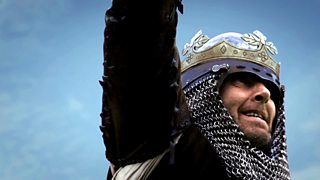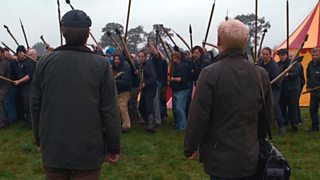Filming the quest: Bannockburn behind the scenes
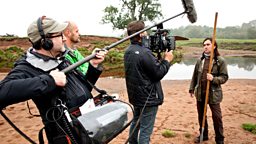
Filming The Quest for Bannockburn took the production team and me all over the United Kingdom and involved the help of a lot of people along the way. Over the course of the year it took to put this programme together, it grew more and more exciting with each day that passed – even if it grew many sets of arms and legs too!
We visited some amazing places throughout England and Wales to tell the story of Edward II and why he wasn’t that popular with his nobles. We travelled to Warwick Castle to film the powerful in action, saw some rare medieval documents about the battle at Durham University and visited the castle in Knaresborough that Edward II gave to his dear friend Piers Gaveston. In Scotland we investigated the roots of the and how Robert the Bruce plotted to become the King of Scotland.
Reenacting the battle
The actual battlefield had changed a lot since 1314 and bears no resemblance to its old self, but luckily we found a brilliant alternative in the Drymen Showground. It looks today very much like the Bannockburn battleground would have looked centuries ago. There’s a great variety of terrain and the river Endrick proved invaluable for some of the larger-scale battle scenes. In September 2013 we set up camp and the showground was to be our mini film set for five days.

The battle weekend saw 80 people from the Clanranald Combat Team re-enact six crucial parts of the battle. We filmed this with three different camera units: a drama unit to film the close-up battle scenes and dramatic moments; a green screen unit to film the scenes needed to show the true scale of the battle; and a documentary unit for the behind-the-scenes training, experiments and preparation to explain and dissect the action for the television audience. In total we had over 100 people on set every day for four days, so it was a huge logistical operation when compared to the three or four people that you would usually find in a TV documentary crew.
The stress of filming helicopter shots
Filming one helicopter from another is notoriously difficult as it involves filming a moving target while on the move yourself. It was particularly difficult to get a choreographed shot of the helicopter going up to Stirling castle and zooming over it.
This takes time and, as a director, you are constantly aware of the massive costs involved with hiring two helicopters and a top-of-the-range gyroscopic camera. I don’t normally get travel sickness but, after two hours of staring intently at a little screen while on the move, I felt rather queasy when the helicopter finally landed!

The reenactment specialists
The really gave their all and, thankfully, a broken thumb and some cuts and bruises were the only injuries. Charlie and Malin Allan run this great team and they have appeared in many films including Gladiator and Robin Hood. These guys are devoted to getting it right, using equipment, weapons and combat clothing and uniforms that would have been used at the time of original battle. Most of the money they earn from appearing in films and TV gets ploughed back into their passion; they have even built near the Carron reservoir behind Fintry.
Kirsty from was in charge of the horses and collaborated with the specialist stunt performers to do all the dangerous stuff like falling off of horses.
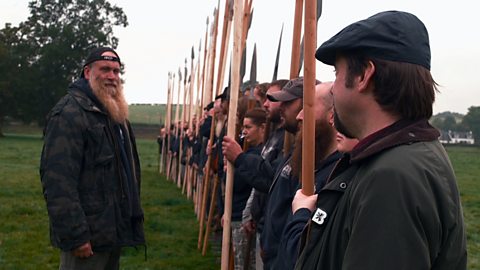
Bruce's schiltrons
How were Schiltrons the deciding factor in the Scots victory?
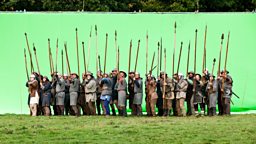
Another star of the show is Scott McMaster from , without whom we would never have been able to make sense of the topography of the battle and work out how brilliantly Robert the Bruce used the natural landscape to defeat an English army twice the size of the Scots'
Filming was a once-in-a-lifetime experience and the passion and commitment of all the different contributing parties really comes across on screen.
